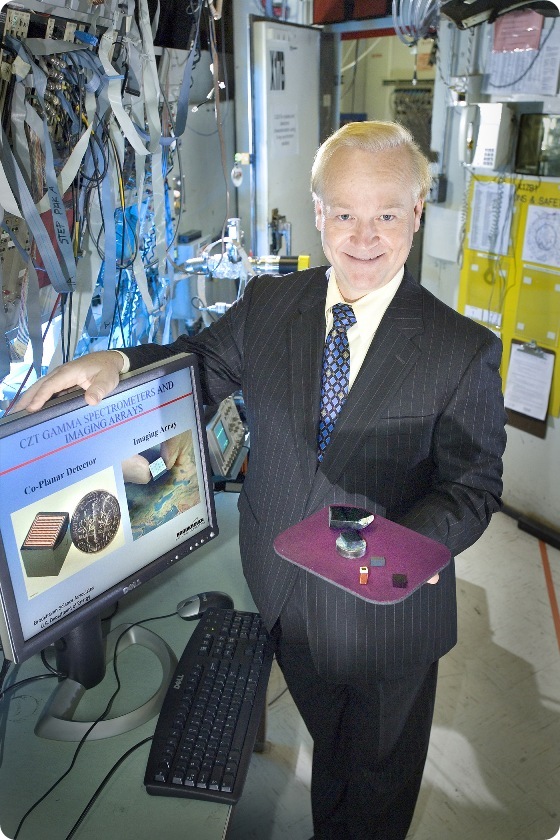Jul 23 2009
The U.S. Department of Energy's Brookhaven National Laboratory and Hybridyne Imaging Technologies, Inc., of Toronto, Canada, have won a 2009 R&D 100 Award for developing a compact gamma camera for high-resolution imaging of prostate cancer.
The camera system, called ProxiScan, is a nuclear medical instrument that can localize cancer tissue in the prostate gland in detail at an early stage, which is important for the successful diagnosis and early treatment of the potentially deadly disease.
R&D Magazine gives R&D 100 Awards annually to the top 100 technological achievements of the year. Typically, these are innovations that transform basic science into useful products. The 2009 awards will be presented on November 12, in Orlando, Florida.
"The Department of Energy's national laboratories are incubators of innovation, and I'm proud they are being recognized once again for their remarkable work," said Energy Secretary Steven Chu. "The cutting-edge research and development being done in our national labs is vital to maintaining America's competitive edge, increasing our nation's energy security, and protecting our environment. I want to thank this year's winners for their work and congratulate them on this award."
The common way to diagnose prostate cancer - the second leading cancer among men, next to lung cancer - is through a blood test that measures the levels of a protein produced by the prostate gland called prostate-specific antigen, or PSA. Elevated PSA levels may indicate prostate cancer, but with a high number of false-positive detections. Often, then, men must have an invasive biopsy, normally guided by ultrasound imagery. Other methods for confirming a diagnosis of prostate cancer include conventional nuclear medical imaging techniques, such as positron emission spectroscopy and single photon emission computed tomography.
However, the current imaging methods have limitations. Benign and cancerous tumors cannot easily be distinguished by ultrasound, and fibrous tissues can be mistakenly identified as tumors if patients have had radiation treatment of the prostate previously. Traditional nuclear imaging systems produce lower-resolution images and are less efficient than Brookhaven's compact digital camera. Also, the detectors in current systems are too large to be used in trans-rectal probes.
In contrast, the new cadmium zinc telluride (CZT)-based gamma camera is small enough for trans-rectal prostate cancer diagnosis, after the patient is injected with a tracer radiopharmaceutical. The high-resolution CZT detector is the cutting-edge technology that drives the novel system. Using this new technology, the working distance between the imaging system and the prostate gland is minimized, allowing urologists to obtain better images with a smaller amount of injected radioactive tracer, compared to conventional nuclear medical systems.
"This project has been a great opportunity to take gamma-ray detector technology originally developed for national security and apply it toward important societal goals in the area of cancer diagnosis and treatment," said Ralph James, a senior physicist at Brookhaven who is the Laboratory's principal co-inventor of the technology together with Brookhaven associate scientist Yonggang Cui.
Cui added, "The CZT material combines the best aspects of conventional nuclear imaging detectors while minimizing their weaknesses. Our experience in detector development and electronics design has been critical in delivering this high performance system in a very compact package at a competitive cost."
Although the CZT-based system was designed to reveal prostate cancer, it can be modified for imaging other cancers, such as cervical, uterine, colorectal and breast cancers. It can also be optimized for surgical use as a probe to guide the removal of cancerous tumors while minimizing damage to surrounding healthy tissues.
CZT detectors have fostered the development of new instruments for measuring radiation. Numerous medical, industrial, scientific, environmental and homeland-security applications exist for this technology, including handheld instruments to reduce the trafficking of nuclear materials and portable field instruments for environmental monitoring and remediation.
The U.S. Department of Energy's (DOE) Office of Nonproliferation Research and Development and Hybridyne Imaging Technologies funded the development of the new compact gamma camera. The inventors have 16 patents on the technology, ranging from detector design and fabrication to imaging. Brookhaven Science Associates, the company that manages Brookhaven Lab, has a patent pending on the advanced CZT detectors.